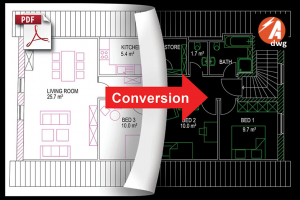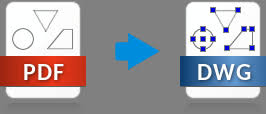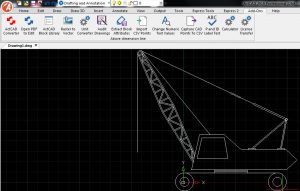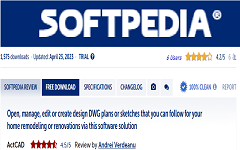PDF to DWG Converter
PDF to DWG Converter is one of the most well-known file conversion format across the world. Practically every device in the market can support PDFs, making the format compatible for exchanging documents and design information.
However, while PDF files are easy to view, editing or modifying them is much trickier. If you wish to make changes in your design (edit, use, or re-purpose) or any elements within it, you’ll need to convert it to a vector image format.
Converting PDF to DWG means that you can edit your design in many of the most popular CAD programs, including AutoCAD and ActCAD.
In this blog, you will get to know about various facts of converting any PDF to DWG.
Here you can find out the different ways/methods of how can you convert a PDF to DWG. This can be done with a comprehensive study of each method and its pros and cons.
PDF File:
PDF, or Portable Document Format, is one of the most commonly used file formats in the world. It is a standard file format for document exchange due to its compatibility with the devices.
PDF files are also popular in the CAD and design field due to their ability to store both raster and vector elements.
It doesn’t matter what hardware or operating system you’re using. PDF files will maintain the same data and formatting across devices.
If we look into many CAD file formats, PDF has the added advantage of being viewable without any specialist software.
All you need is a PDF Reader. You can view it on your PC, Tab or mobiles whenever you want.
PDF has the ability to support both raster and vector elements and smaller file sizes. These PDFs are a perfect choice for displaying the original design without any alterations.
DWG File:
DWG (Drawing) is the native file format of AutoCAD, one of the popular CAD software in the market. Anyone who has ever worked with CAD will be familiar with this format.
DWG (from the drawing) is a proprietary binary file format used for storing 2D & 3D design data and metadata.
It is the native format for several CAD packages including, AutoCAD, ActCAD, ProgeCAD, etc.
It was created around the 1980s. The DWG files created by the CAD applications are used by interior designers, architects, engineers, technical consultants.
The vector image data that the DWG file contains, provides some instructions in terms of code. This tells us how to display the data onscreen. DWG boasts as one of the broadest range of features of any vector file type.
It is capable of supporting the full range of vector entities including elements specific to some CAD software, such as dynamic blocks and allows for both 2D and 3D graphics.
A DWG file is also usually smaller in size than an equivalent DXF file, mainly due to its binary makeup. The ubiquity of DWG amongst CAD users means that the vast majority of designers will be familiar with this format.
Nonetheless, though designed to be used with CAD Software, there are now many ways to view and edit DWG files including conversion from PDF to DWG.
PDF to DWG Converter:
PDF is the best and perfect format for sharing your designs. It is safe in the knowledge that any collaborators will be seen exactly, no matter what their operating system, hardware or software is.
However, it hits a major stumbling block when it comes to editing. PDFs are mainly very difficult to edit. That means they need to be converted to another format in order to edit.
Another issue is that PDF files can store both raster and vector elements. The raster elements in a PDF are, by nature, not easily editable.
In addition, their quality depends on the resolution at which they are displayed. When you alter the scale or zoom in, the image will lose definition and appear blurry which is not clearly visible.
Meanwhile, though PDFs can display some vector elements, the range of available entities is very limited. Most of the vector image editing software is incapable of editing PDF files.
In this case, if some CAD software has inbuilt functionality to convert any PDF to DWG. ActCAD is able to convert both the raster and vector elements in a PDF to DWG format. It ensures that you are able to edit the entire file.
By converting the PDF to DWG, you can also scale the image, and edit and reuse individual elements.
ActCAD 2020 Professional CAD Software:
ActCAD(inbuilt PDF to DWG) is a popular and pretty nice 2D CAD drafting and 3D modeling CAD software used by architects, engineers, interior exterior designers, professionals and in many Industries.
It is based on the latest IntelliCAD Technology Consortium (ITC), Wintopo, ODA Teigha Libraries, ACIS 3D Kernel, etc. ActCAD uses the recently released version of IntelliCAD 8.4b to offer the best performance to its customers.
ActCAD software contains many important tools like CAD converters like PDF to DWG, raster to vector and many more block libraries and which have blocks belonging to different domains in Mechanical, electrical, civil, architects, etc.
According to the customer’s satisfaction, It is one of the leading CAD software. Full Functionality perpetual licensing and that too at an affordable price is the efficacious feature of ActCAD. It is driving the world towards it and has emerged as a powerful firm.
Conversion of PDF to DWG in ActCAD is very easy. You can select any PDF file to convert it from PDF to DWG or vice-versa.
We know to edit a PDF file is not an easy task and when it comes to design. You can’t keep more effort with the confidentiality of that design.
So, basically what we need is a CAD software where this function should be inbuilt in itself. So, the user will not have to look after any other outside resources for converting PDF to DWG or other conversions. dwg or dxf, raster pdf, scanned pdf, free online, lines polylines splines.
Steps to convert PDF to DWG:
It involves 3 simple steps, you can go one by one.
1. Open ActCAD and click on ” open PDF to Edit.

2. Select the PDF file to convert from PDF to DWG

3. After selecting the PDF file, click on open it will be converted to DWG.

Conclusion:
After discussing the conversion of PDF to DWG on the basis of various points we can conclude that the ActCAD software is the best option available for you to convert your files.
The confidentiality, security, standard of drawing and accuracy is maintained by CAD software with an embedded CAD Converters.
We can keep our drawings and open it on other devices. This is because almost every device is capable of opening a pdf file. This feature provided by ActCAD.
So we can easily say that ActCAD is more user-friendly and provides more flexibility to the user and more superior to other CAD software in many aspects and we can clearly visible from the above discussion.
It increases the turnover of industries and is proved as an asset to them. No matter if we talk about the cost, features, reliability everywhere ActCAD is leading.








